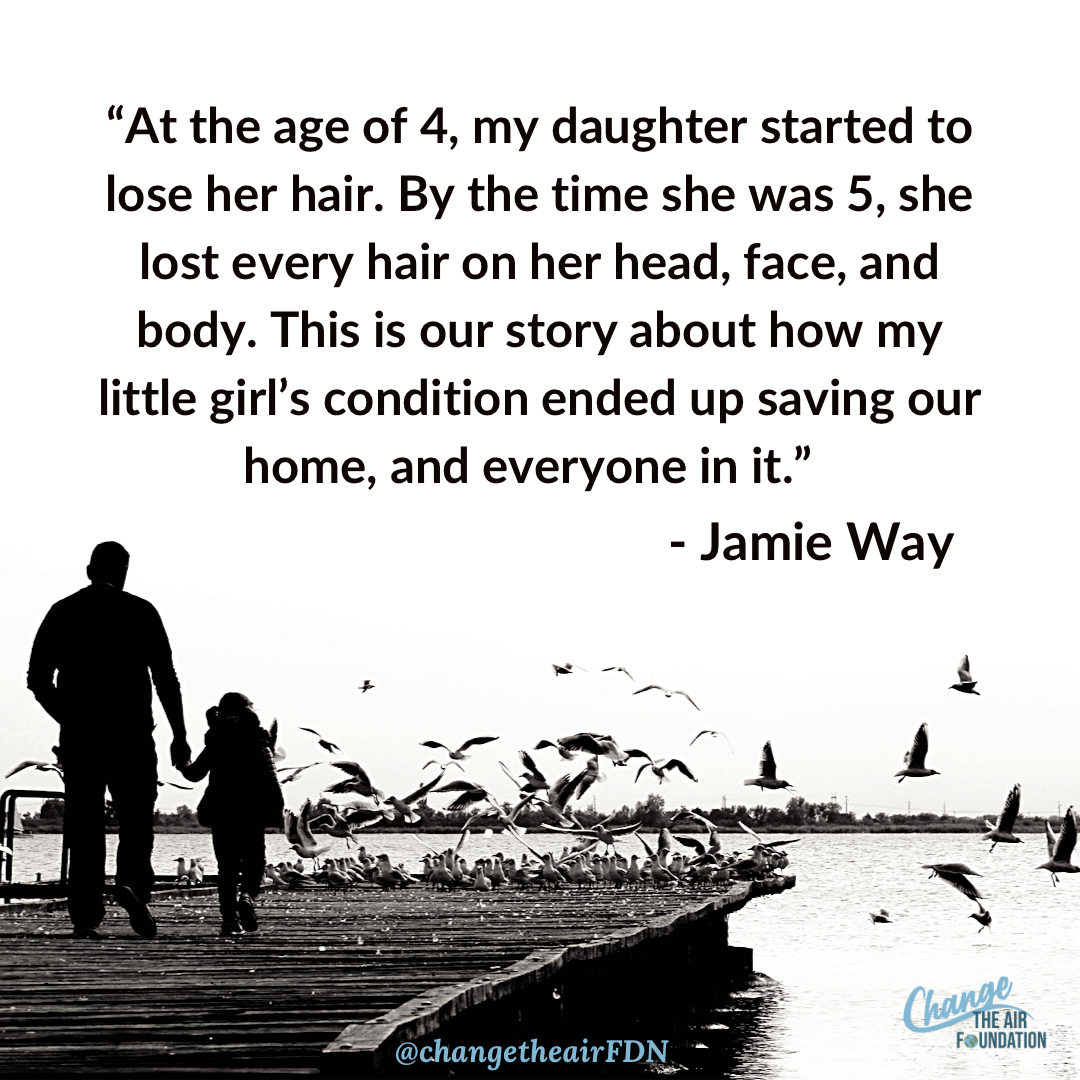
At the age of 4, my daughter started to lose her hair. By the time she was 5, she lost every hair on her head, face, and body. This is our story about how my little girl’s condition ended up saving our home, and everyone in it.
In October 2018, I was on a 5-hour drive home from a wedding when my wife called and told me a large chunk of our daughter’s hair had fallen out overnight. My daughter must have been in the room when she called because she interlaced the phrases “everything is fine” and “nothing to worry about” throughout the call. In the best way I could, I told her it was probably nothing to worry about. “It's just hair.” After the call, she sent me a picture, and I couldn’t recognize what I was looking at. All the hair from her neck to the back of her head had fallen out. It was a good thing my friend was behind the wheel because I immediately felt flushed with a hot nervous ache in my stomach. That car ride seemed to slow down to a stop.
"Mom said everything is fine," my daughter immediately assured me when I got home. “I’m sure it is, don’t worry,” I said. But the quiet glances my wife and I shared said a lot more. At the base of her head, there were still stringy thin hairs left. But in between those last few strings, her scalp was so smooth. As if the hair follicles had vanished.
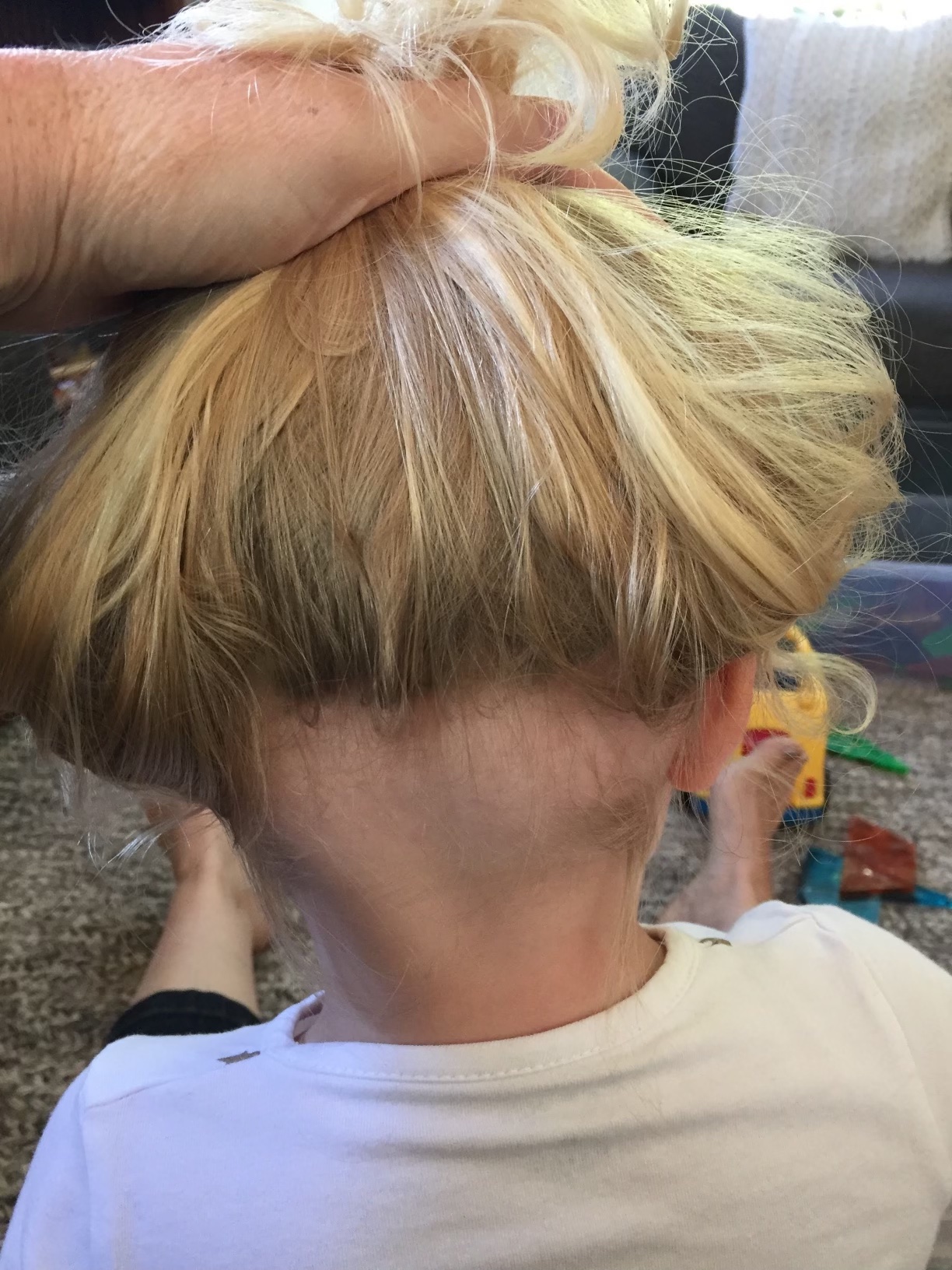
"Mom said everything is fine," my daughter immediately assured me when I got home. “I’m sure it is, don’t worry,” I said.
Diagnosis
Within a few days, we met with my daughter’s pediatrician. During our visit, there were no answers, just questions. What’s her diet? Was she sharing hats? Just a room filled with confusion, curiously pulling at straws for clues. We didn’t expect to have answers right away, but something about that first visit made our suspicions sink in deeper. The level of anxiety in our house was palpable and silent that night—like an intimidating stranger just quietly moved in unannounced, with no plans to leave.
At the first meeting with our new dermatologist, she explained to us what alopecia is. We were told it’s an autoimmune disease and that it’s a genetic condition. Some people grow out of it, and some don’t. I had never heard of it until that moment. We left the meeting confused but with a task to investigate our family history. There have been cases of psoriasis, eczema, and shingles—all autoimmune issues—but no alopecia. Our doctors, the internet, and conventional wisdom had already convinced us that there was no cure for alopecia. We held on to the hope that maybe she had something treatable. But not long after the first visit, more hair covered her pillow, more hair filled the brush. Her hair loss was now coming out in patches on the top of her head and thinning on the sides. It progressed so fast that by our second doctor’s visit, our suspicions were confirmed and she was diagnosed with alopecia areata.
“Her system is inflamed and attacking her hair follicles like they are intruders.” This was the theory our dermatologist told us. One way to correct this response is to give the body a real inflammation issue to deal with. We were prescribed squaric acid and ditho cream and told that the longer we could keep the treatment on, the better. We were asked to apply the acid to my 4-year-old daughter’s head, with hopes it would distract her system from attacking her hair. We were then warned to avoid getting it on our hands and sheets because it will stain.
Every night for almost a year we would put on our gloves and apply the acid. It got to the point that she would spend the night with the treatment to maximize the exposure. We tried to make it special and gave her different color shower (swimmy) caps to choose from, switching between blue, pink, and purple. Purple was her favorite, so it was washed daily. Her scalp became blistered and red. Her lymph nodes at the base of her head became puffy and ballooned into her neck. We were told this reaction was good news. The bigger the inflamed reaction, the better because it showed an active immune response. With encouragement, we kept going but it was frightening. We wanted to stop, but we were scared and confused. Whatever it took to help her condition get better, we’d do.

"It got to the point that she would spend the night with the treatment to maximize exposure... Her scalp became blistered and red."
Every morning during that time, there would be chunks of hair melting off her in the shower. And every day in that shower my daughter sang her big heart out. She acted as if this was an extra-special shower treatment and loved the attention. She sang and I did my best to not let her see that my eyes were just as red as her scalp was. Her attitude taught me so much about resilience and strength. We had to learn fast how to just be there with her. Play, not worry. Just be. Be supportive when she needed it and not make a deal about it. It was at night, after she went to bed when we talked. Worried. Obsessed over answers.
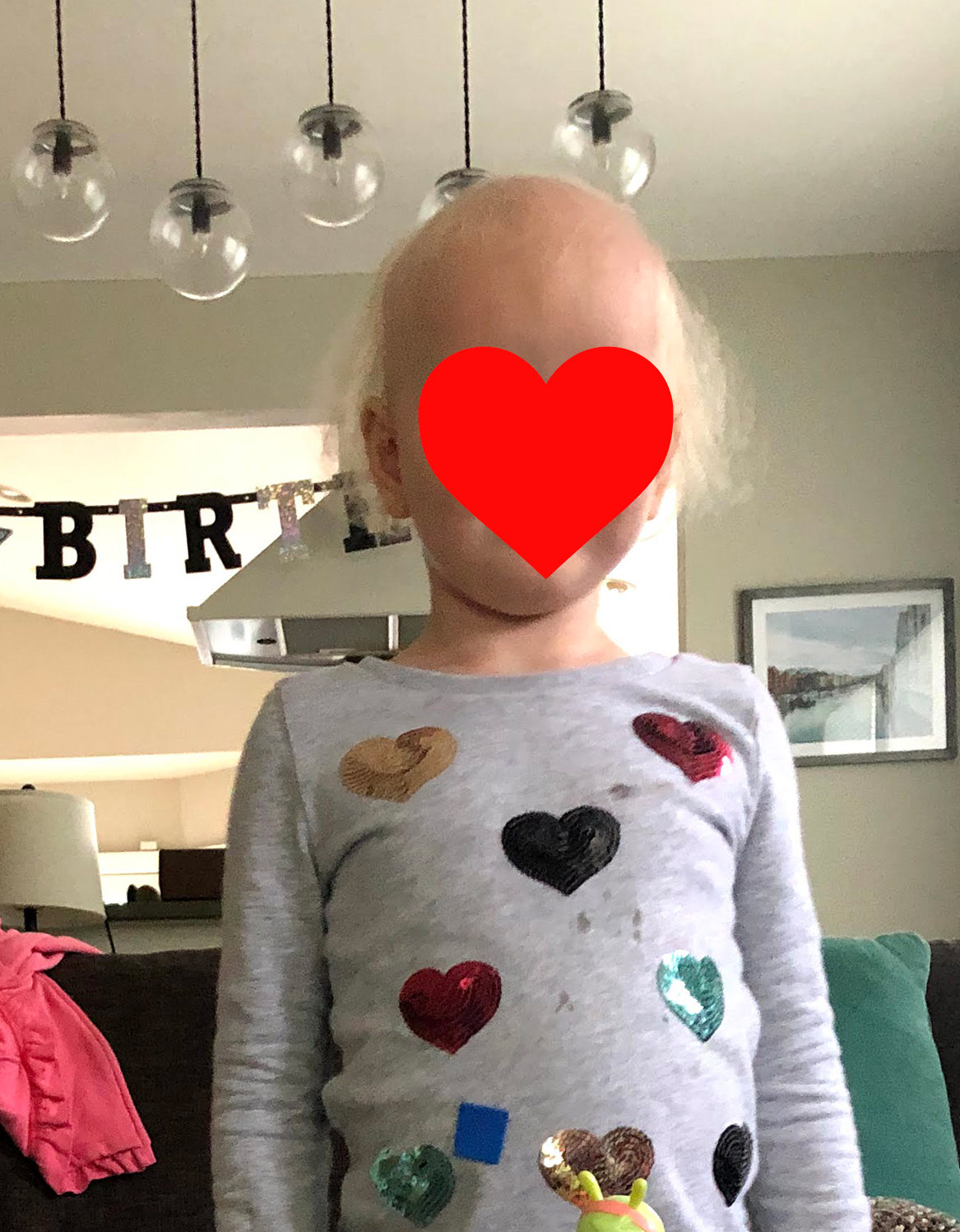
"Her attitude taught me so much about resilience and strength. We had to learn fast how to just be there for her. Play, not worry. Just be... It was at night after she went to bed when we talked. Worried. Obsessed over answers."
Blood test after blood test found nothing out of the ordinary. Lead, celiac, thyroid, you name it, we did it, in one sitting. It was torturous. The stress was too much for this little one. “No more blood,” she made us a promise. The results came back clear, and our efforts seemed lost. Her doctor calmly explained that we must let her condition take its course. She began to talk to us about wigs during the office visits and handed us business cards to some local specialists. We would leave the office more confused and more helpless than the previous visit. Over time, that feeling began to take root and normalize itself.
Within 8 months, every hair on her was gone. Her condition was now named alopecia universalis. She had lost all hair on her scalp, eyelashes, eyebrows, arms, everywhere. It was as if every follicle vanished. Her skin was so smooth it was almost rubbery, and my fingers would stick to it. The tone from our doctors shifted from treatment to acceptance. We began to say it is healthier for our stress levels to accept that there's no cure. Our focus shifted to the “forever-ness” of this condition. We would need to teach her how to live with it. “At least it’s just hair” was the most used quote from strangers, family, and doctors.
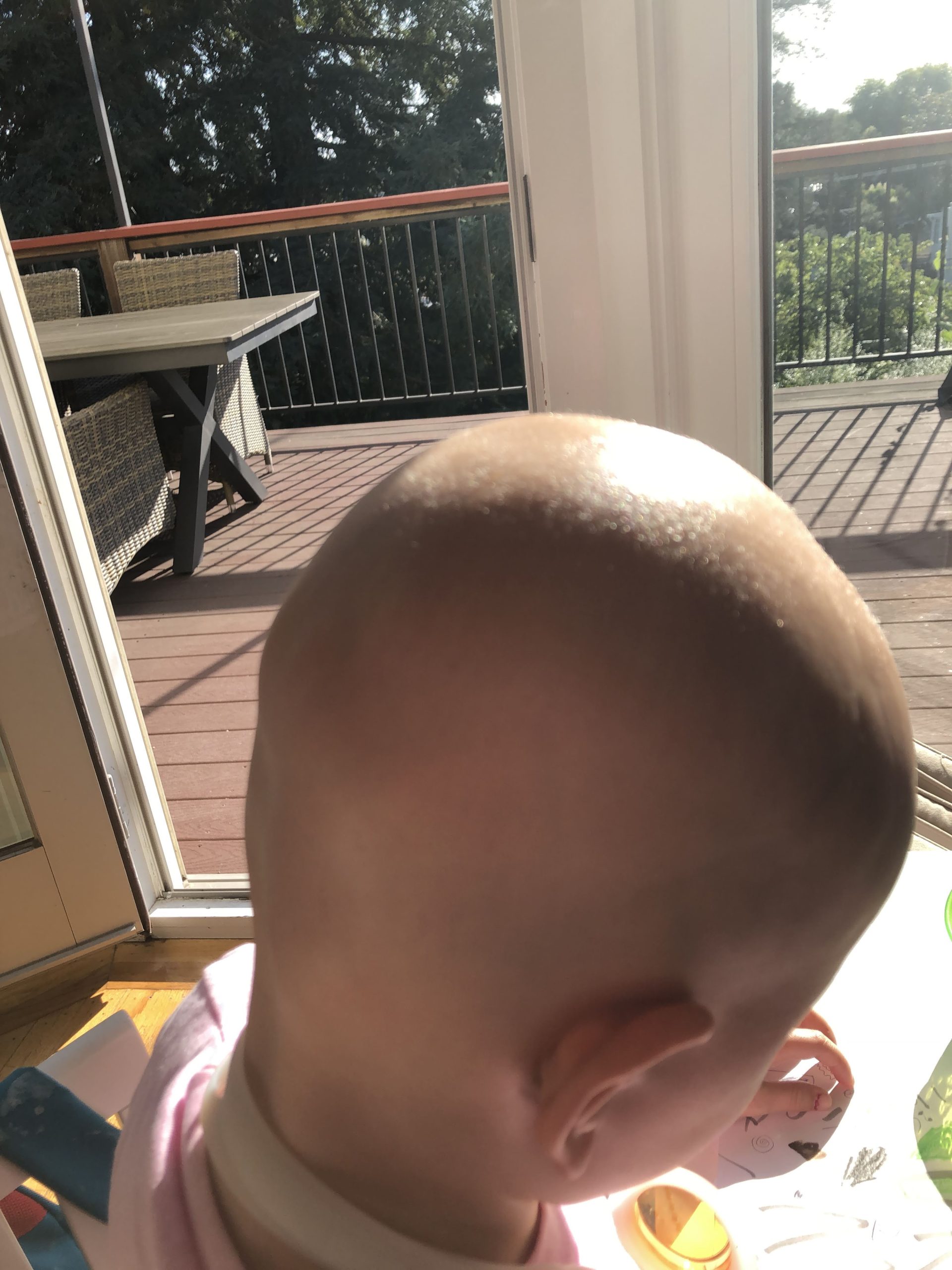
"Our focus shifted to the 'foreverness' of this condition. We would need to teach her how to live with it. 'At least it's just hair,' was the most used quote from strangers, family, and doctors."
At night the conversations became more about logistics. What will it be like at school? Can she wear hats in class? What do wigs cost? How can we build her up? We were lucky that her preschool was so supportive during this time. We couldn't have asked for a better system of amazing parents and kids. We had to teach our daughter what to say when asked and prepped our family and friends with this new “allergic to hair” script.
Change of Perspective
Every 2 to 3 months for almost 2 years we visited our dermatologist. Our plan stayed consistent, except for an added children’s Allegra every morning. There was a no-end-in-sight policy for the daily Allegra and acid, and it slowly began to wake me up at night. Acceptance as a treatment was not sitting well. Slowly but surely, something had to give.
Our very last visit to the dermatologist started out normal. We talked about various new treatments and ways to increase our routine of acid and allergy medications. But my frustration had been building days before this visit. I asked our doctor, “You have a child. If this was happening to your child, what would you do?” My tone wasn’t harsh, but it was desperate, sweaty, and teary. I shouldn’t have put her in this situation, but I was starving for answers. She calmly described that she didn’t know what she would do. She reinforced that there's no cure. It's genetic. Her response was honest. But it was the same thing we were told when we were diagnosed. No progression. Just practiced acceptance. A frantic voice inside me asked all the questions that I wouldn’t say out loud. This was not her child—how could she relate? How could she feel the same anxiety and urgency that I had? On our way out, I was handed another card for a local wig specialist. This time around, I felt confused and duped.
I knew we couldn’t go back to that office. There were no answers for us there. But what could we do on our own? As my mind ran through every idea possible, my daughter skipped down the hospital hallway, excited to spend time with her daddy. She held my hand tight and skipped. Her instinct was to console me. I didn’t know what to do next, but I squeezed that hand back as she skipped all the way to a toy store down the street. I told her to get anything she wanted. She grabbed a golden dragon stuffy for some reason that made me feel more hopeful. The rain came out of nowhere as we walked to the bus stop. Unprepared, we waited for the bus with no umbrella. I stood there drenched with this amazing little girl and her golden dragon tucked under her arm. This moment changed my whole perspective. I would search for an answer, but I would do this detective work carefully, with her in mind first. Follow the facts. Don’t chase a cure. And just be with her.
“If this was your daughter, and there were no limits, what would you do?” This was a common question I’d ask friends and family over many months following that visit. I avoided talking about her condition as much as I could because it at times felt like a burden for others. I may have projected that onto other people- but my initial response was to keep this close to the chest. Unless I was talking with family. In a talk with my sister-in-law, she gave me a great gem. She discussed gut health. She told me about a study where they used fecal transplant pills to heal people’s gut imbalances. I never thought her belly could have anything to do with her hair. My obsession grew. I needed to know everything. The keywords “fecal transplant + alopecia” sent me down a Google rabbit hole that lasted for months.
Trial and Error and Repeat
On Christmas Eve 2019, we waited in our car for our takeout order to finish. The kids were asleep in the back seat while the rain smothered the windshield. It became a habit that when I had a window of time, I googled alopecia. Before bed, on my commute, just bored, I googled all things related to my daughter’s condition. That night the search was all about fecal transplants. I found an article from a company that spoke about it and how alopecia can be cured through lifestyle and environmental changes. Curious, I emailed and connected with the company’s owner, and it launched me into a whole new direction of healing. That brief window of time, as we waited in the rain for Indian takeout, shaped my next 2 years.
Alopecia Angel’s owner became a sounding board. She worked with me to troubleshoot my daughter’s condition and gave me a lot to think about regarding the lifestyle and health of our home. She got us on the right path to find the cause of my daughter's “leaky gut,” which was causing her body to respond through alopecia.
In a search for an autoimmune trigger, we started with an AIP (Autoimmune Protocol) Diet: remove any food that may be hard on your stomach lining and give it time to heal. No dairy, no grains, no nightshades (potatoes, eggplants, tomatoes, peppers), no "natural flavoring." Then reintroduce foods one by one and watch for a reaction. It sounded good on paper, but the look on her face was heartbreaking as I told her we couldn’t eat certain foods. She looked so defeated, and she kept asking what was wrong with her. If anything, this diet made her feel more "different." It was one of the first times she truly felt separated from other kids. I promised I would do this with her. All the foods, vitamins, and tests. We were in this together. I did that so she wouldn’t feel alone, but also I knew something was off with me too. The more I researched, the more I saw similar symptoms in myself. My body just didn’t have an alopecia response. This could be our little project.
As a mainly vegetarian house, we knew our diet lacked some key elements. I learned about the gut-healing benefits of organ meats and bone broth, but we weren’t ready for plates of pâté. So, that meant we had to teach our daughter how to take vitamins. Small frozen blueberries were the trick. The first day we started our practice, it did not work. It was a slobbery mess, with big tears and hugs. We paused for a few days, let things cool, then picked it back up. By the third or fourth day, she got one down and felt so proud. Then we went 2 at a time for about a week before we attempted the real vitamins. Our list of vitamins was D3, probiotics, grass-fed desiccated beef liver capsules, and digestive enzymes. It was a lot! We bought extra-small vitamin capsules and transferred the insides of normal-sized vitamins into the small capsules, so she could swallow them. With my clumsy fingers, this process took at least 45 minutes each night. She got the hang of it soon enough, and every day we’d take extra-small vitamins morning, noon, and night.
My wife got really into AIP cooking. Once she understood what fats and grains were harmful to sensitive bellies, she began to make recipes and experiment on us. She would try out different tapioca-flour pancakes and waffles, she made ridiculous brownies that are grain- and dairy-free, grain-free pasta, and fish tacos with cassava tortillas. She was incredibly good at making it fun. She made all my research tangible and livable. She kept it fun, which bought us time to try and find a solution. New treats, new hats, new adventures. Anything to just keep the little one from burning out while we figured out how to heal. This was truly the key to our progress. I could not have done this dance on my own, and we fell naturally into our roles. I was the “research + vitamin guy”; she was the “make this real-life + fun foods and hats guy. And our partnership grew a lot during this time.
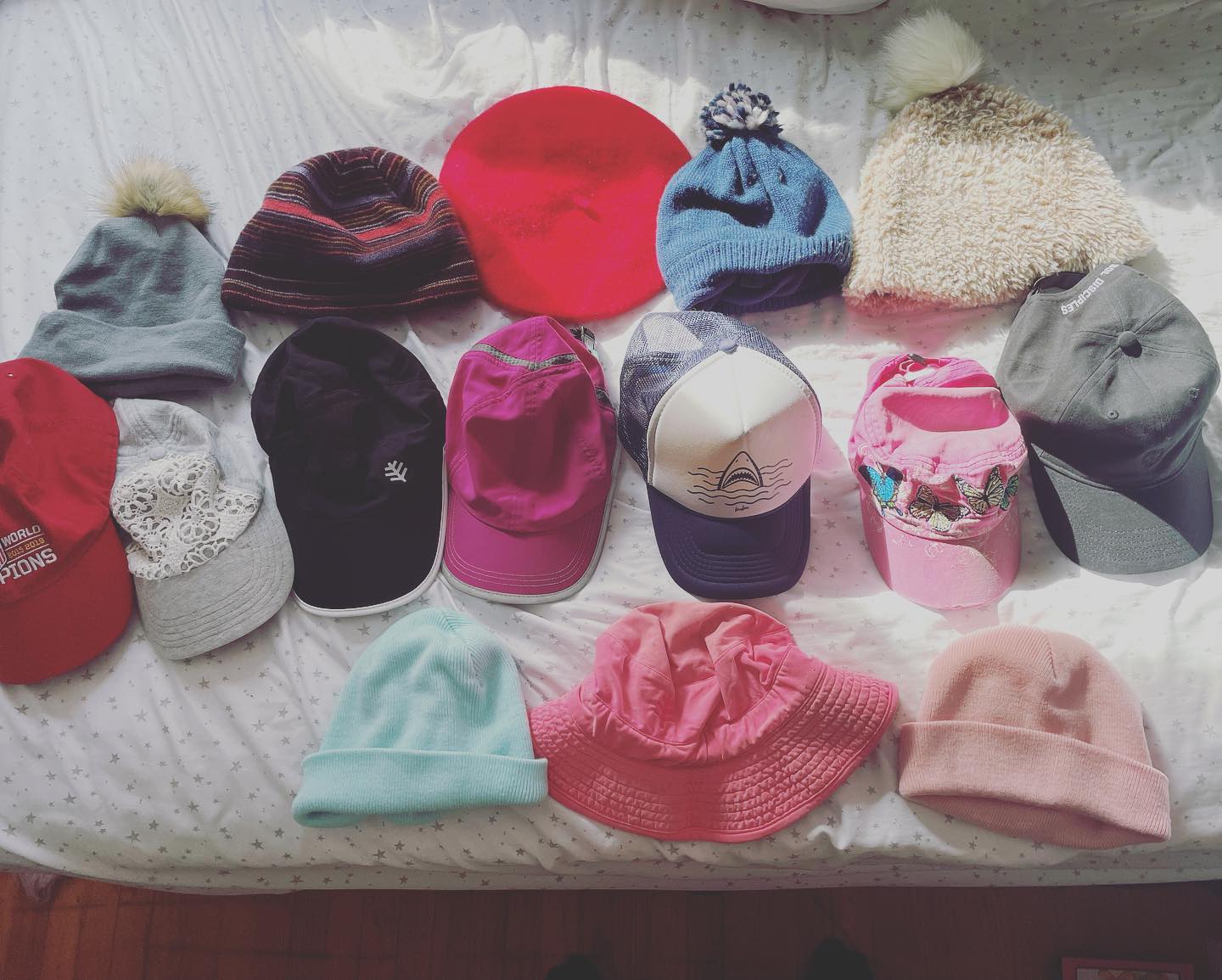
"She was incredibly good at making it fun. She made all of my research tangible and livable. She kept it fun, which bought us time to try and find a new solution. New treats, new hats, new adventures."
After about 6 months of diet and vitamins, we started to see tiny hair buds, and her eyelashes began to peek out in small translucent slivers. It was amazing. We knew we were on the right track. But the giant pile of daily mini-vitamins didn’t seem sustainable. The meal restrictions began to weigh on my daughter. It became another way for her to feel different and isolated. It was a lot of effort for little gain. Something was missing.
To Become a Detective
“Maybe food is the cause, but what else could we rule out as a trigger for her condition?”
This was the thought that woke me up at 3 AM every night around the summer of 2020. I became obsessed with autoimmune triggers. I read articles, research studies, and books about food sensitivities, Lyme disease, lead, and mold. I looked at our life and according to these books, blogs, talks, and studies, we were doing everything wrong. We had plastic containers, nonstick pans, polyester blend sheets, no water filter, and no air filter. How did I not know any of this information? We started the game of remove and replace. Out with the plastic, in with the glass, cast-iron pans, and water and air filters.
One night, searching for answers on my 3 AM ceiling, I remembered the water leaks. Over the years, there were several leaks in our home. We patched issues as they arrived, but nothing structurally was addressed. Curious, I bought a DIY mold test kit from my local hardware store. I botched the test and then contacted a professional with the highest Yelp reviews. They ran some indoor and outdoor air tests. An air trap test attempts to grab mold spores from the air and use the outside air as a control. I learned later they are super inefficient. Many mold toxins (mycotoxins) are heavy and settle on surfaces and collect in the dust. The chances of finding them in the air are slim. Test the dust.
That initial inspection did not give us the full picture, but it did provide 2 clues: one spore of stachybotrys (“black mold”) in my daughter's room, and one visible mold patch in our room downstairs. I was told stachybotrys is a red flag, and the mold downstairs was due to improper drainage. A remediation company arrived to safely remove the visible mold and address the red-flagged spore. They remediated the visible mold and surrounding wall along with the downstairs bedroom and put in an industrial high-powered HEPA filter in my daughter’s room. Her room was sealed with a plastic barrier and a jet-powered fan ran inside it for 3 days. While she slept in our room, the tiniest translucent hair popped out on her scalp. In a matter of 48 hours, it grew to almost half an inch! We hadn’t seen a hair that long in years.
We got a clean bill of health for both rooms. We added a new drainage system to our house. For 2 whole weeks, I slept great. Then the 3 AM ceiling showed up again. Within days of my daughter being back in her room, that one beautiful strain of hair disappeared. It also never made sense why her room would get a positive mycotoxin reading when the only mold we discovered was on the opposite side of the house. Where else could it be? We wrote down every issue we could think of: The roof had leaks. The air vents had never been cleaned. The bottom of the house 2 stories below her room had leaked due to poor drainage. The more we learned about our home, the more it felt like we were in a sinking ship with a thousand little holes all over the boat.
“Stachybotrys + alopecia” was the next Google rabbit hole I went headfirst into. I ingested all I could about how mycotoxins affect different health conditions. Was that one mold spore we found in her room the missing piece to her condition? We needed tests. But we were now 9 months into our holistic detective work, and every new angle to investigate became a strain. This research has resulted in real money spent, with very little sign of regrowth. Though we had some validation that her health was improving, still, it began to weigh heavy on us because it all felt so unsure. We made a deal: Test to see if we have been exposed to mycotoxins. If we test positive, we’ll continue down this road. If not, we’ll slow down and just focus on diet.
California law states that only your doctor can order toxicity tests on your behalf. We emailed our pediatrician, excited to share what we’ve discovered and why these tests are important. In her response, she refused these tests and questioned our discovery. We were politely told this is out of scope for her office. We then contacted our dermatologist, who we hadn’t spoken to in almost a year, and she denied these tests too. She questioned the relevance of this kind of test and claimed it was pseudoscience. I was shocked by the immediate denial and the lack of curiosity. We found toxins in her room and just wanted to see if it affected her body. We wanted to rule things out. We’ve done all the blood tests and treatments they’ve recommended before, why did we get such a strong response that denied a urine test?
We were both taken aback, and we were not convinced. Initially, we just wanted a simple test, but now it felt like we were really on our own. They didn’t believe us. It was not an easy decision to pull away from our dermatologist’s recommendations, and we didn’t do it lightly. Over the years it felt as if we were caught in between a battle of 2 sciences. We didn’t approach this on an ideological quest. We wanted to heal our kid, and we would use all the information needed to do so. We began to talk to functional medicine doctors who focused on toxicity and gut health. We were lucky enough to find a great doctor. Through her guidance, we ordered tests for my daughter, and as part of my deal with her, we ordered the same tests for myself.
Her test results came back showing results with exposure to lead, methane, and mycotoxins! She also had gut dysbiosis. We felt overwhelmed but also somewhat vindicated, grateful that we had a new sense of direction.
Lead: Her earlier blood tests showed no lead issues, so how could this be? I started working with a great plumber, and we went through all the pipes in our house. I tested our water, and it came back clean. I tested the dust, and it showed elevated lead levels on the windowsill outside of her room and in the dust under her dresser that was right across from the window. Lead in the paint was blowing into her room.
Methane (Gas): I called the local gas company to come and test the house for any leaks. They came over immediately and found the tiniest leak on our water heater, which is located beneath her room, just a few doors down. Our plumber came over to patch it up right away. But how long had this been leaking?
Mycotoxins: Not knowing enough about this subject, I wasn’t sure how to test the house. I hired a company that did a thorough house inspection, but they just looked for visible signs and elevated moisture with thoughts that if there was no moisture, mold would eventually die off. I found out later that dead mold is still dangerous, and some can go dormant but return like an annual flower and remain potent for years. If I knew what I know now, I would have hired an indoor environmental professional (IEP) who understood the science behind mycotoxins and how to test the dust with an ERMI test. For the third time, I tested for mold the wrong way.
Keep Digging (Intuition)
At the start of 2021, we were on our crusade to fix any leaks in the house. We replaced a 30-year-old roof and some leaky pipes under our kitchen sink. I asked one of the workers to scrape down the outside of my daughter’s windowsill and repaint it. As he began to scrape off the paint, the wood was so rotted through, it crumbled in his fingers. It looked like pulled pork. He checked the windowsill inside her room to see how far the damage had spread. His putty knife sunk into the wood like butter. At this point, she had been sleeping next to this rotten window for 4 years.
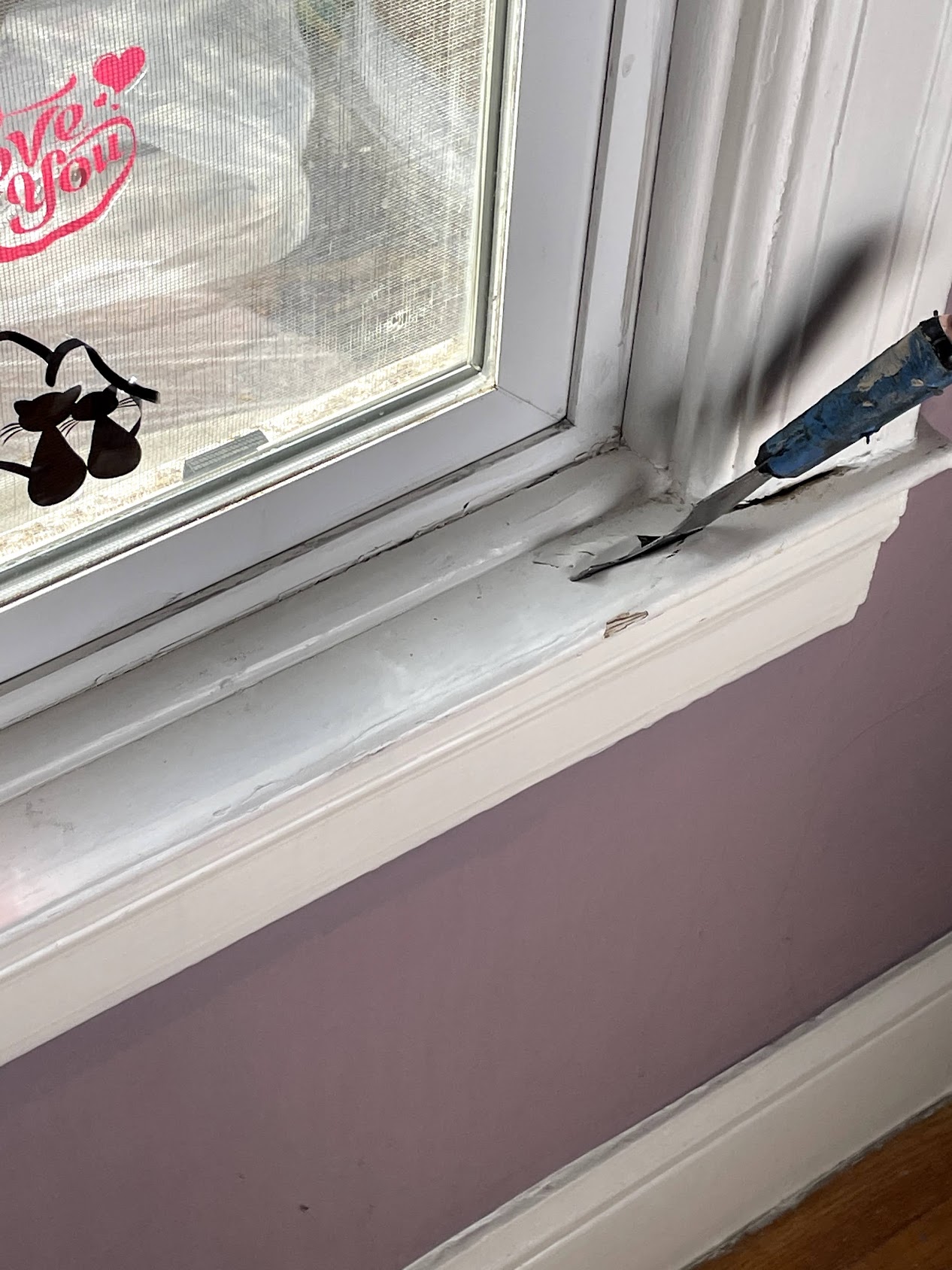
"As he began to scrape off the paint, the wood was so rotted through, it crumbled in his fingers. It looked like pulled pork... At this point, she had been sleeping next to this rotten window for four years."
The mold inspection didn’t test properly for mycotoxins, but it did give me a gem. The inspection paper said to have your remediation done by a company with a CMRS (Council-certified Microbial Remediation Supervisor) stamp. This certifies that individuals are trained to understand mycotoxins and the connection between the home and human health. Once we discovered how rotten the window was, we stopped and wrapped it in plastic. I called a qualified remediation company that was CMRS-approved. Because of the lead dust, they had an abatement company remove the affected materials. The second plastic barrier in 4 months was put in my daughter’s room. The window and the surrounding wall were removed. It turns out her walls were built out of stucco, and the mold hadn’t traveled far. It was explained to me that if it was drywall, her whole room could’ve been covered. Once we got her window fully replaced, we threw out her bed, pillows, and blanket because toxins can make homes in fabric.
While contractors worked to replace the window, I knew the house was not done. I was advised by Bill Weber (CMRS), who helped me understand how mold grew and why crawl spaces are so important to the health of a home. He explained that we breathe our basement air, according to the "stack effect." Air flows through a house based on thermal differences between outside and inside air. This movement of air creates a vacuum that pulls outside air inside the crawl space or basement and up into your home. If your crawl space is exposed dirt, which ours was, your home's temperature and air quality will change as the ground water evaporates and toxins will travel through the floorboards.
We ran an ERMI (Environmental Relative Moldiness Index) test in that dirty, uncovered crawl space, and it came back with 940,000 cells of Penicillium brevicompactum/stoloniferum, which can produce dangerous mycotoxins. I hired a company to vapor-lock the exposed dirt with a membrane sealed into our foundation. Then the remediation crew came in. They built a plastic barrier at the entranceway with a 50-foot giant plastic tube that went outside of the house. Then they worked for 4 days, scrubbing every inch of our crawl space with organic dish soap, healing the belly of our home.
When they finished, we could feel our house begin to cool down. There was an energy shift that happened. It felt as if that stranger at the beginning of this journey decided to pack up its anxious and intimidating energy and finally move out.
Recovery and Reflection
The lighting is amazing in our home around 3:30 to 5 PM. The afternoon sun would shine in and reflect off my daughter's scalp in just the right light now to show us where we were on this journey. I took pictures at this time of day to track what was happening. When she initially lost all her hair, nothing changed for a long time, but once a week we still took pictures. Through our diet and supplement efforts, we saw little buds pop up. They were small and subtle but would glisten in that afternoon light.
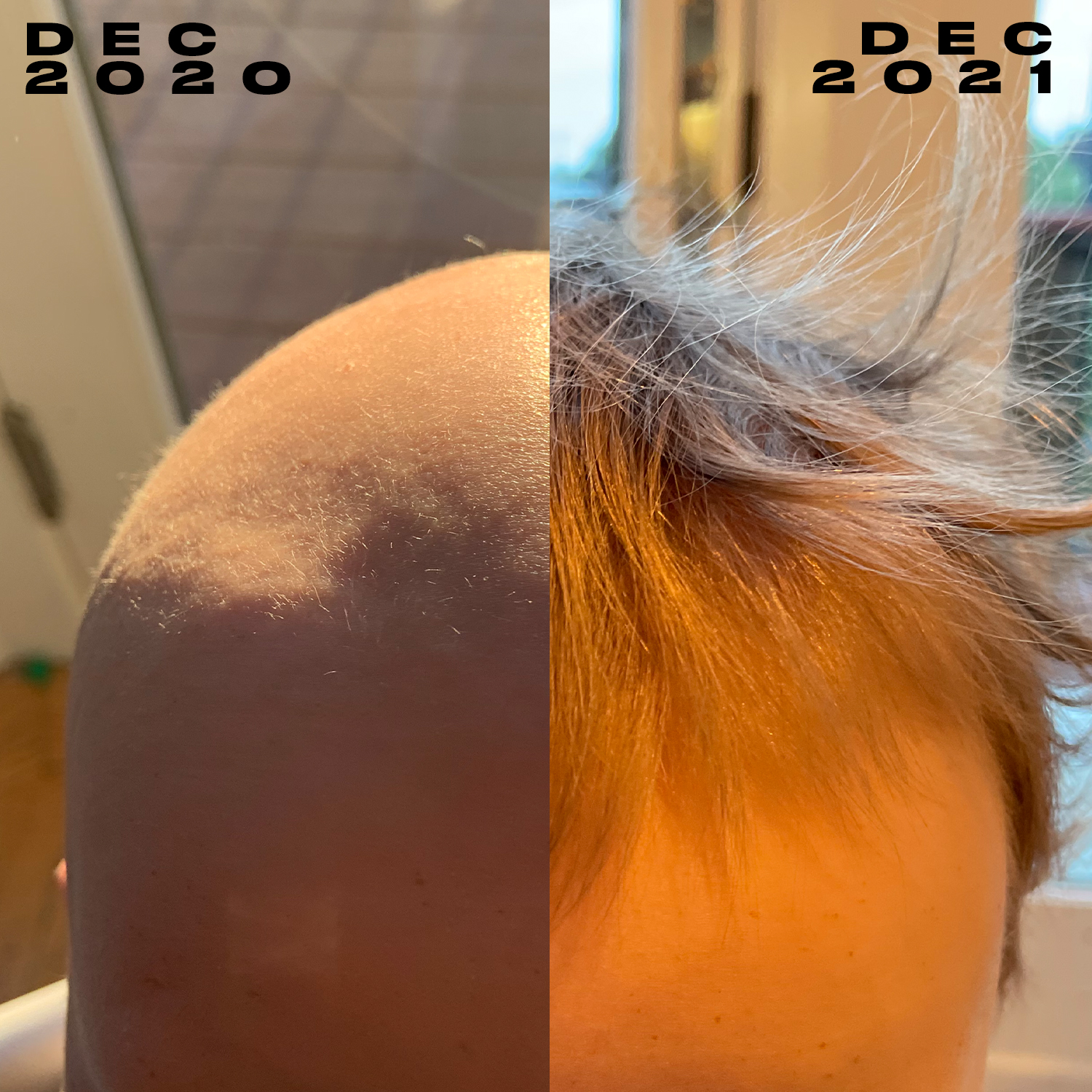
"After her window was replaced, it was like a switch in her was turned on. One afternoon a thick patch of new hair appeared. Not one stand-alone hair that we've seen come and go. Hundreds of little hairs huddled close together and layered on top of each other." - Jamie Way
After her window was replaced, it was as if a switch in her was turned on. One afternoon, a thick patch of new hair appeared. Not one stand-alone hair that we’ve seen come and go. Hundreds of little hairs huddled close together and layered on top of each other. I can't remember if we screamed, but we probably did. This beautiful patch about the size of a dime showed up on the back of her head. The next day, it was accompanied by little dots all over her scalp that shined in that afternoon light. After all this time, her body began to respond and flourish.
“Keep going baby, keep going.” This was my wife’s mantra after every new hair arrived. This kept us focused. Celebrate, but see it all the way through. Every 5 days or so we would see new patches. At first, it was random where they would appear, but eventually, when one patch started to gain length, the follicles underneath it would come to life and support it. They started to connect to and grow toward each other. Thin little white eyelashes appeared in clumps, changed color, and began to get longer. Out of nowhere, one eyebrow arrived in full, the other one trailed 4 months after. Leg and arm hairs seemed to all show up at once. It was incredible to watch, and we appreciated every active follicle.
My health began to recover as well. It turned out the mycotoxins were a key factor of my gut dysbiosis. I lost most of my stomach acid and the ability to break down proteins properly. The chronic inflammation is expressed in my own genetically wired way, and I’m still working through it.
My daughter and I took 10 to 12 vitamins a day and various mucosa drinks before we removed the mold. It never felt sustainable, but I believe it primed her system to recover fast once the main source of her inflammation was removed. Since its removal, we’ve simplified our daily routine. Every morning, we have probiotics, prebiotics, omega-3s, and zinc. In the Afternoon, we take B12 and biotin with magnesium.
Reflection
"What if I lose it again?" she asked a while back. I told her she is beautiful and strong, and incredible no matter what. If there was a regression, we would test ourselves and our home again, then respond to the results. We have a plan that we’ve earned through trial and error, research, science, and a whole village of people who are behind every hair grown. Knowing there is a plan makes us all feel more assured. Since our diagnosis, we are constantly told there’s no cure for alopecia. But let me be clear: We didn't cure her alopecia. Alopecia is a genetic response to chronic inflammation. We discovered what was causing this inflammation and removed it. Once there was nothing to respond to, she began to heal. So the wording of “there is no cure” doesn’t sit right. How could you ever “cure” genetics?
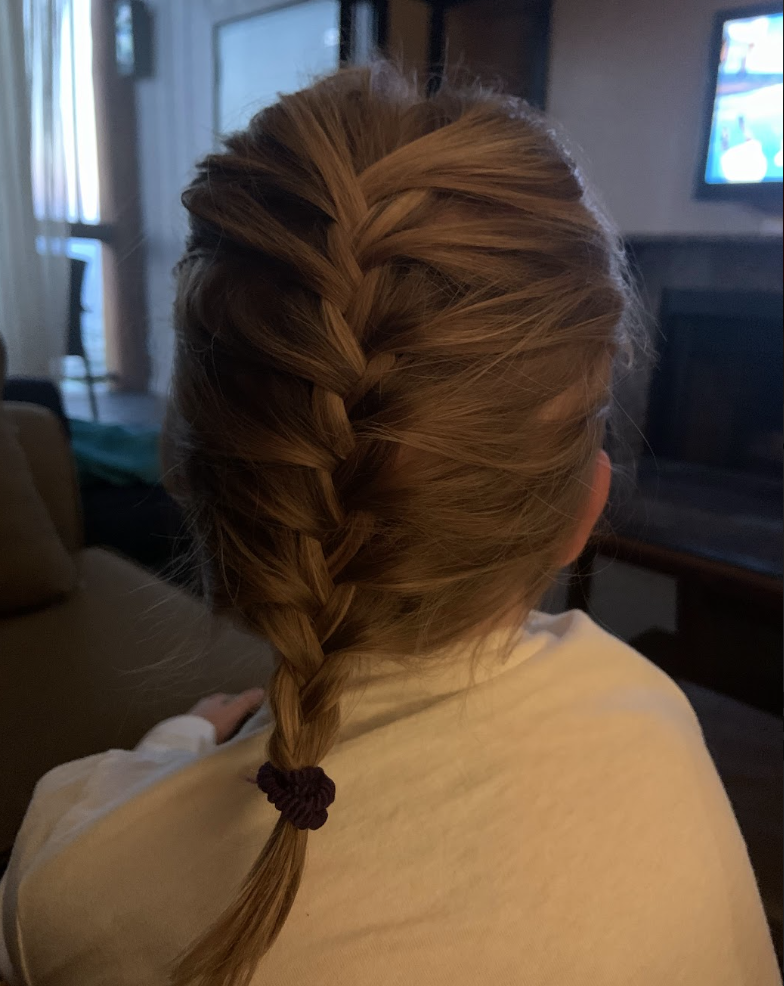
"Since our diagnosis, we are constantly told there's no cure for alopecia. But let me be clear: we didn't cure her alopecia. Alopecia is a genetic response to chronic inflammation. We discovered what was causing this inflammation and removed it."
She has blossomed over the last year and a half since we removed these toxins from our home. Yes, her hair has come back and is growing more each week. But most important, her health has never been better. Our whole family is healthier than we’ve ever been from taking on this journey. This magical little girl taught me more about resilience and strength than anything else in life. And I must wonder, how many other families could be suffering from hidden indoor toxins and not even know it? Everyone's story is different, and our steps may not fit yours. But I hope this story can spark inspiration to be your own detective. Leave no stone unturned. It’s a journey, but you're worth the trouble. Just keep going baby, keep going.
